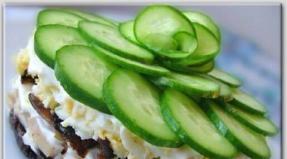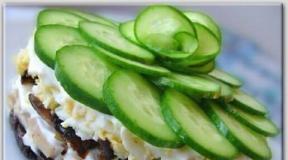Non-stop: annual flowers for the whole season. A flower garden that blooms until frost - choose plants. Seedlings of which flowers are not afraid of frost.
In May there are often night frosts, during which heat-loving plants can die. To prevent this from happening, you need to prepare for a drop in air temperature in advance. What measures should be taken to save the garden from spring frosts?
Return frosts are a temporary decrease in air temperature below 0°C, which usually occurs at night or early in the morning. Such unpleasant surprises may occur periodically until the end of May.
How do you know if there will be frosts in May?
Meteorologists voice weather forecasts for a fairly wide region. And often the weather varies significantly in different places. Therefore, you need to try to determine for yourself whether you should expect frost in your area.
In most cases, there are frosts at night, when after a hot day at about 8 pm the air temperature begins to drop sharply. At the same time, the sky is clear, and the weather is calm, windless and dry. If in the evening the wind rose, clouds appeared in the sky, and the grass was covered with dew, then there is nothing to worry about: at night there will be no critical drop in air temperature.
Early flowering stone fruits that are susceptible to spring frosts are best planted in elevated areas or near water bodies. In these areas, warmer air is retained around the trees.
What plants are afraid of spring frosts?
Newly planted seedlings of heat-loving vegetables (tomatoes, peppers, eggplants) and garden flowers suffer most from frosts in spring. When the thermometer drops to -2°C, these plants stop growing, so the harvest can be harvested 10-15 days later.
For all melons and strawberries, a temperature drop from –1°C is detrimental. Greens (onions, parsley, sorrel, spinach, dill) and carrots can withstand frost down to –7°C, and celery safely tolerates temperatures down to –5°C, therefore these crops do not need careful protection from small spring frosts.
Raspberries and blackberries almost do not suffer from spring frosts at night, since they bloom quite late. And currants, gooseberries, blueberries, grapes, apples, pears, plums, cherries, cherries and apricots are very sensitive to return frosts. Garden strawberries are also afraid of a sharp drop in air temperature, however, thanks to the rather long flowering period, part of the strawberry harvest can still be preserved.
Spring frosts are dangerous for roses, salvia, as well as for specimens grown as annuals (nasturtiums, marigolds, zinnias, dahlias, chrysanthemums). Therefore, do not rush to plant seedlings in the ground while the likelihood of frost is high.
The sensitivity of plants to lower air temperatures also depends on the stage of bud break. For ovaries, frosts of -1°C are terrible, blossoming buds die at -3.5oC, frosts of -3oC are unbearable for buds, a blossoming flower cannot withstand -2oC, and at the end of flowering even -1.5oC can be fatal. Fruits from such flowers will no longer be able to develop.
Ways to protect against late spring frosts
To protect heat-loving plants from frost, you need to know the most effective methods protection. In some situations, you may have to resort to more than one of them.
Smoke
Smoking a garden during frost is a well-known, but not very popular method, since it is difficult to keep smoke in the area, especially in windy weather. And the constant smell of a fire is not pleasant to anyone.

Fires are organized on the leeward side of the site at the rate of one per hundred square meters. Firewood, dry tree branches, straw, leaves, dried grass, etc. are set on fire. The main thing is that the material smolders and does not burn overnight. Since the last frost often occurs early in the morning, it is important to make a large fire (about 1.5 m wide and at least 0.5 m high) so that it does not go out in the middle of the night. But just in case, it’s worth checking the fireplace several times a night and adding “fuel” to it.
The smoke method increases the air temperature by only a few degrees, so it is effective only if frosts down to –4°C are expected.
Sprinkling
Frost protection by sprinkling is practiced more often than smoke protection. This method is convenient if a stationary irrigation system using sprinklers is installed on the site. But a regular hose with a nozzle will also work.
Irrigation of plants is carried out several hours before expected frosts: as a rule, late at night, since severe frosts occur at dawn. At low temperatures, moisture evaporates and thereby warms the air. As a result, the frost does not reach the ground.

Warm-loving crops are not only irrigated with water. For trees and shrubs, moisture-charging irrigation with water at a temperature of about 10°C is very effective. One tree uses 5-10 buckets of liquid.
You can increase the evaporation of moisture using a transparent film, which is covered under the crown of trees after watering the tree trunks. During the day, the spring sun warms the ground, shortly before the onset of frost, the film is removed - and warm steam rises, protecting the crown of the plant from freezing.
Covering material
A simpler and most popular technique is the use of covering materials that protect plants from contact with the external environment. For this purpose, mini-greenhouses are used, plastic film, spunbond, glass bottles, cut plastic bottles, caps made of thick paper, etc. But keep in mind: the frost shelter is put on so that the leaves of the plants do not touch the material.

Hilling
To protect young potato sprouts (with 3-5 leaves) from return frosts, you need to cover them with earth using a hoe. The layer height should be 7-10 cm.
Mulching with organic matter
This technique is good for vegetable crops. After watering the plants in the evening, straw, compost and dry grass are laid out on the beds. A layer of organic mulch reduces soil heat transfer and increases surface moisture.
Warm beds made with organic matter also warm crops well from below. And if you additionally cover them with agrofibre, then in such a greenhouse the plants will not be afraid of even severe frosts.
Feeding
Spraying with phosphorus-potassium fertilizers helps plants better withstand low temperatures. The fertilizer is prepared as follows: 50 g of double superphosphate is poured into 1 liter of hot water, left for 3-4 hours, filtered and diluted in 10 liters of water. Then 20 g of potassium nitrate is added to the working solution.

If the weather “whispers” that there will be frosts, it won’t hurt to add phosphorus and potassium to the roots. But this needs to be done about 10 hours before the thermometer drops to negative values.
What to do after frost?
If the plants are still damaged, do not despair! Special “antidepressants” for plants will come to the rescue, helping them to “relieve” stress from low temperatures. IN Lately The drug Epin-Extra has proven itself well. It will be very effective if spring frosts become dangerous for grapes and tomatoes. But it is unlikely that it will be possible to revive eggplants and peppers: these crops are especially sensitive to stressful situations.
Svetlana Shcherbak from Krasnoyarsk shares her personal experience of growing petunias in Siberia:
What sub-zero temperatures can petunia withstand in open ground?
It is believed that petunia, as a typical representative of the nightshade family, does not tolerate frost. Reputable experts and experienced flower growers on the Internet report that modern petunia hybrids, in exceptional cases, can withstand short-term temperature drops of up to -2 degrees, and after -4, they turn black and lose their flowers. It is noted that those specimens that are planted in open ground. And for petunias that are suspended in flower pots or located on the balcony, light frosts are not so bad.
Frosts and my petunia: Personal experience
I have not yet encountered spring freezing of petunias, which I have been growing for a very long time.
- Firstly, I am never in a hurry to move seedlings to a permanent place. I do this no earlier than the first, or even the second week of June.
- Secondly, my seedlings are perfectly hardened: starting from the second half of April, the night temperature in the greenhouse regularly drops to 4-5 (sometimes 1-2) degrees.
- And thirdly, I follow the forecasts of meteorologists and take the necessary measures.
I plant petunias in 10-liter flowerpots, one or two roots at a time. The petunia garden is protected from the prevailing northwest winds by a gazebo and a greenhouse.
I place the pots on elevated surfaces (bench, stumps, stands). This way my petunias are on a slight elevation.
In Siberia, return frosts are not uncommon. If the temperature dropped for a couple of hours to -1 or -2 degrees, there were no consequences for the already planted crops.
But when it unexpectedly got colder to -4, it happened that astilbe, annual dahlias, uncovered tomatoes froze (I never encountered eggplants and peppers freezing - they are always covered), even young zucchini. And although at this moment you look more at who is frozen and blackened, the petunias never let you down, they stood firm and did not pay attention to themselves (by blackening). Perhaps the frost came in a streak or was short-lived.
How to revive a frozen petunia
If the petunias are still frozen, and the damage is not total, you need to try to save the petunias:
- bring the sufferer to a comfortable place;
- cut off the affected leaves, you may have to sacrifice twigs;
- the main thing is that the trunk and two or three sinuses remain healthy; new branches will quickly grow from them, and the petunia will definitely turn into a beauty.
How to protect tender petunias from frost
Experts strongly recommend hardening off seedlings before planting them in the ground. I fully support it! From the first days, my seedlings grow in Spartan conditions. In April, the high sun warms up the greenhouse under the polycarbonate to a serious 30–40, the ventilation cannot cope with cooling. And at night 4–5 degrees is a common thing; since the second ten days of May I haven’t even closed the door at night.
After planting them in permanent pots and placing them in the garden, I am interested in the weather forecast every day, not only for “today,” but also for the next 3–4 days. If there is a threat of freezing, I don’t rely on hardening, I try to cover everything I can. In this matter I prefer to play it safe.
There are also such signs: in the evening the sky is clear, without clouds, and the thermometer is below 5 - it will definitely be frosty; If there are thick clouds or drizzling rain, you don’t have to worry about frost.
If the frost is expected to be mild, a suitable container inverted over the spreader will suffice: a plastic glass or bucket will do. cardboard box, an old saucepan, just a package. Usually this is enough.
A lifesaver in many cases is garden non-woven covering material.
In the greenhouse you can place containers (buckets, tanks) with hot water, turn on the electric heater.
It is known from grandmothers that the garden can be protected with smoke; to do this, they light fires and throw in dry mullein, damp logs or grass, and peat.
Fires are lit in the open air; they are contraindicated in a greenhouse! If there is no electricity, it is better to make do with containers of water, or install a stove with a chimney.
Flowerbeds can be covered with spruce branches or a thin layer of branches, for example, willow.
What varieties of petunias are not afraid of frost?
I think that no petunia will survive serious frosts; after all, it is a heat-loving flower, and even a nightshade. But I wouldn’t call him a sissy either.
I noticed that, as manufacturers promise, modern hybrids are endowed with resistance to extreme conditions. They quickly recover from strong winds, drought and rain; in my opinion, they tolerate heat worse.
I plant many varieties, and I’m happy with all of them (in terms of durability). Here are just a few of our favorite hybrid groups:
- terry bush and cascade (Duo, Pan-Velvet and others series);
- ampel and cascade (Ramblin, Opera, Imperial, Gioconda, Avalanche, Baby Duck series);
- multi-flowered and large-flowered (Picobella, Eagle, Shock Wave, Pikoti, Grandiflora Aladdin);
- fringed grandiflora and frillitunia.
Everyone is quickly recovering from the squally winds and heavy rain. If they are thirsty and have already lowered their “ears”, they almost instantly restore their cheerful appearance after watering. And they calmly withstand short-lived, light frosts, both in spring and early autumn.
I appreciate petunias not only because they decorate even a modest garden all summer, they are unique, so different. The main thing for me is that they do not require much trouble and tolerate our harsh Siberian climate very well.”
Svetlana Shcherbak, Krasnoyarsk region
Spring return frosts can cause a lot of problems. A sharp drop in temperature can destroy the future harvest, so it is important to prepare for it in time and learn in advance how to protect plantings and seedlings from frost. The danger of spring frosts in the Urals is not so high at the end of April and beginning of May - young plant leaves may freeze along the edges, but over time they will recover. But if the frost hits in early June, not only will they suffer garden crops, but also fruit trees. Let's figure out the dangers of returning spring frosts, how to predict them and, most importantly, how to prevent their harmful effects on plants.
Why are spring frosts dangerous?
 The damage that return frosts can cause to many representatives of heat-loving crops is enormous. In the first months of spring, they do not pose a particular threat: young plants that have just put out leaves will not have time to freeze. In the worst case, only the edges of the leaves will be damaged, but it won’t take long before they recover. A much greater danger is fraught with late return frosts that occur in middle lane Russia until the 10th of June. They coincide with the flowering of berry crops and fruit trees, the emergence and planting of seedlings of heat-loving tomatoes, peppers, eggplants, etc., for which sudden spring frosts are destructive. Young leaves, flowers and buds are incredibly sensitive to cold and are unable to withstand it. Under the influence of low temperatures, cell sap begins to freeze, which causes ruptures of cell membranes, leading to cell death and, ultimately, to the death of plants.
The damage that return frosts can cause to many representatives of heat-loving crops is enormous. In the first months of spring, they do not pose a particular threat: young plants that have just put out leaves will not have time to freeze. In the worst case, only the edges of the leaves will be damaged, but it won’t take long before they recover. A much greater danger is fraught with late return frosts that occur in middle lane Russia until the 10th of June. They coincide with the flowering of berry crops and fruit trees, the emergence and planting of seedlings of heat-loving tomatoes, peppers, eggplants, etc., for which sudden spring frosts are destructive. Young leaves, flowers and buds are incredibly sensitive to cold and are unable to withstand it. Under the influence of low temperatures, cell sap begins to freeze, which causes ruptures of cell membranes, leading to cell death and, ultimately, to the death of plants.
If the seedlings are not hardened and are poorly rooted, they stop growing at a temperature of -2°C, and the fruiting period is delayed by 2 weeks. Some crops tolerate return frosts well and are able to withstand sharp drops in air temperature. But the majority of plants, after a sharp cold snap, slow down in their development, and their yield noticeably decreases.
Which plants can withstand frost?
Radishes, carrots, cabbage, parsnips, lettuce, parsley, onions, horseradish, sorrel, rhubarb, spinach and carrot shoots can withstand temperatures down to -6°C. Garlic, celery, peas, beans, parsnips - up to -5°C, strawberries - up to -9°C, raspberries will withstand a couple of days down to -4°C.
What plants are afraid of spring frosts?
Seedlings of flowering annuals and heat-loving melon plants creeping along the ground can be damaged even at -1°C. Spring frosts are dangerous for fruits and berries, especially during the formation of ovaries and flowering of the latter, which can lead to loss of yield. The buds of fruit trees freeze slightly at -4°C. Cherries, peaches, apples and pears are especially vulnerable. For them, a drop in temperature even to -2°C is detrimental. If cucumbers, tomatoes, peppers, eggplants, zucchini, pumpkins, squash, beans have already been planted or sprouted, and frost is expected, you need to take care of their preservation, because they cannot tolerate even short-term frosts. Just in case, you need to have seeds for reseeding or spare seedlings.
How to predict spring frosts
 Despite the fact that the Ural winters have recently become noticeably warmer, the likelihood of spring return frosts has increased. Of course, it is impossible to predict them 100%. But you can use the hints of Mother Nature and the forecasts of weather forecasters, which, admittedly, have become quite accurate. To be sure that the forecast is correct, it is better to compare data from several sources (television, Internet, etc.).
Despite the fact that the Ural winters have recently become noticeably warmer, the likelihood of spring return frosts has increased. Of course, it is impossible to predict them 100%. But you can use the hints of Mother Nature and the forecasts of weather forecasters, which, admittedly, have become quite accurate. To be sure that the forecast is correct, it is better to compare data from several sources (television, Internet, etc.).
Folk signs of the arrival of frost
♦ If the thermometer drops to +1-2°C in the evening, it may be frosty at night. Warm-season crops will require shelter.
♦ The absence of clouds in the sky, calm and cessation of precipitation may indicate a subsequent drop in temperature.
♦ Bird cherry blossoms usually foretell an imminent cold snap.
How to protect plants from frost
There are a lot of methods for protecting plants from frost. Some of them, as practice shows, are quite labor-intensive, questionable or ineffective. Let's look at the most popular ones: sprinkling, smoke, shelter, the use of fertilizers and growth stimulants.
Sprinkling method
 This method is used when the temperature drops to 0°C. To sprinkle, you need to put a fine sprayer on the watering hose (the stream should look like raindrops) and completely spray the trees and shrubs that may be damaged by frost with water. As the water freezes, heat will be released, which will save the plants. Beds with plants are also watered using a sprayer attached to a hose (watering can), or using a system drip irrigation. Watering is carried out in the evening, literally a few hours before the expected frost. As soon as the temperature drops closer to 0 °C, the water will gradually begin to evaporate. The resulting steam will serve as reliable protection for the plants. The fact is that it has a large heat capacity, which means it will not allow cold air flows to the ground, and plants will be able to safely endure short-term frosts.
This method is used when the temperature drops to 0°C. To sprinkle, you need to put a fine sprayer on the watering hose (the stream should look like raindrops) and completely spray the trees and shrubs that may be damaged by frost with water. As the water freezes, heat will be released, which will save the plants. Beds with plants are also watered using a sprayer attached to a hose (watering can), or using a system drip irrigation. Watering is carried out in the evening, literally a few hours before the expected frost. As soon as the temperature drops closer to 0 °C, the water will gradually begin to evaporate. The resulting steam will serve as reliable protection for the plants. The fact is that it has a large heat capacity, which means it will not allow cold air flows to the ground, and plants will be able to safely endure short-term frosts.
The sprinkling method is considered quite effective when frozen to -5°C. True, it will only help in calm weather. Otherwise, your efforts will simply be wasted.
Smoke method
 The smoke method, as a means of protecting plants from frost, has been one of the most popular and effective for decades. The essence of the method is that fires are lit in the area and a warm smoke screen is created. It softens the negative effects of frost on plants. Fuel can be straw, sawdust, small brushwood, fallen leaves, potato tops and even manure. It is not so important what material will become the basis for saving fires. The main thing is to prevent it from burning quickly: it is necessary that it does not burn, but smolders, emitting a large amount of smoke. To do this, most of the above materials must be burned wet.
The smoke method, as a means of protecting plants from frost, has been one of the most popular and effective for decades. The essence of the method is that fires are lit in the area and a warm smoke screen is created. It softens the negative effects of frost on plants. Fuel can be straw, sawdust, small brushwood, fallen leaves, potato tops and even manure. It is not so important what material will become the basis for saving fires. The main thing is to prevent it from burning quickly: it is necessary that it does not burn, but smolders, emitting a large amount of smoke. To do this, most of the above materials must be burned wet.
The fire must be arranged in such a way that the smoke spreads throughout the treated area. Determine in advance where the breeze is blowing from (if there is a strong wind, there is no point in using the smoking method). One fire about 1.5 m wide and 40-60 cm high is enough to process 1 hundred square meters. For its construction, pre-prepared material is distributed in this way: about 20 cm of dry material (leaves, brushwood, straw, etc.) is laid on the bottom, and a layer of wet material (up to 40-60 cm) is placed on top, which will be the source of smoke. A three-centimeter layer of earth is evenly distributed on top, leaving a small space in the center: smoke will pass through it. All of the above is true for small areas. If there is a need to use the smoking method over a large area (for example, in large gardens), it is more advisable to use smoke bombs rather than fires. Smoke begins as soon as the thermometer approaches 0°C. It should continue until sunrise: that’s when the temperature reaches its peak minus values. Therefore, by sunrise the area should be covered with a thick layer of smoke. Despite its popularity and a number of advantages, the main ones being the relative ease of execution and low cost, this method also has disadvantages, due to which it is today considered, if not ineffective, then at least questionable. Disadvantages of the smoke method:
♦ Impossibility of use during strong winds.
♦ Not environmentally friendly - smoke from burning dry leaves and other garden waste is harmful.
♦ There must be a slight breeze present for the method to work. It is extremely rare to observe it at night during frost, when the pressure is high. If there is no breeze that could carry warm smoke around the area, then there will be no sense from the smoke either - the smoke will simply go into the sky.
Creating shelters for plants
from scrap materials
 Simple structures made of various covering materials and a frame made of wood, reinforcement or metal-plastic pipes - i.e. something like small greenhouses. Creating such shelters will not take much time, and it does not require special knowledge, but the benefits will be enormous. In addition, dismantling them if necessary is as easy as installing them. The simplest shelter, which can safely be called a greenhouse, can be easily built from several identical pieces metal-plastic pipe, bent into an arc and installed in a row at a distance of approximately 50 cm from each other. An ordinary thick film or any other covering material is stretched on top: 1 layer in case of a slight cold snap and 2 layers if the cold snap promises to be stable.
Simple structures made of various covering materials and a frame made of wood, reinforcement or metal-plastic pipes - i.e. something like small greenhouses. Creating such shelters will not take much time, and it does not require special knowledge, but the benefits will be enormous. In addition, dismantling them if necessary is as easy as installing them. The simplest shelter, which can safely be called a greenhouse, can be easily built from several identical pieces metal-plastic pipe, bent into an arc and installed in a row at a distance of approximately 50 cm from each other. An ordinary thick film or any other covering material is stretched on top: 1 layer in case of a slight cold snap and 2 layers if the cold snap promises to be stable.
To protect flowering shrubs - karyopteris, cyanothus, David's buddleia and others - from frost, just wrap them with burlap, film or agrospan. Strawberry flowers, which die already at a temperature of about -1°C, must also be covered with agrospan before the onset of light frosts. Small plants can be covered with cut-off plastic bottles, paper caps or plastic buckets (large cups) from sour cream. Ordinary soil can also be an excellent shelter from frost. So that the potato seedlings are not damaged, it is enough to simply hill them up. Covering hilling will help protect the leaf mass and reliably protect the mother tuber, which means that the potatoes will not be afraid of frost. Hilling can be repeated until the threat of return frosts has completely passed. Covering the potatoes will help protect them. The exception is cases of planting potatoes with mini- and microtubers, botanical seeds, as well as layering and sprouts. The fact is that at the beginning of the growing season these plants are still very weak. After hilling, they simply will not be able to break through the thick layer of soil and will die. Shelters made from scrap materials do an excellent job and reliably protect plants from frost. The main thing to remember is that whatever protective material you use, it should not touch the leaves.
Frost protection in greenhouses and greenhouses
 If frosts are expected in the area of -4...-7 °C, you will have to take additional care of the inhabitants of greenhouses and greenhouses: they also need shelter. To do this, you can use old newspapers, burlap or modern covering materials - agrospan, lutrasil, etc. In the case where it is not possible to cover the plants inside the greenhouse (you won’t be removing already grown tomatoes and cucumber vines from the supports), the greenhouse itself must be insulated. To do this, build an additional covering from the same materials. It can be secured both outside and inside. Just don’t attach the second covering close to the first; leave a small air gap between them: this way you are guaranteed to protect all the “inhabitants” of the greenhouse from frost. If plants need to be covered for several days, then it is advisable to use modern covering materials, more about which you can learn from THIS article. It is advisable to remove covers from plants no earlier than 8-9 am.
If frosts are expected in the area of -4...-7 °C, you will have to take additional care of the inhabitants of greenhouses and greenhouses: they also need shelter. To do this, you can use old newspapers, burlap or modern covering materials - agrospan, lutrasil, etc. In the case where it is not possible to cover the plants inside the greenhouse (you won’t be removing already grown tomatoes and cucumber vines from the supports), the greenhouse itself must be insulated. To do this, build an additional covering from the same materials. It can be secured both outside and inside. Just don’t attach the second covering close to the first; leave a small air gap between them: this way you are guaranteed to protect all the “inhabitants” of the greenhouse from frost. If plants need to be covered for several days, then it is advisable to use modern covering materials, more about which you can learn from THIS article. It is advisable to remove covers from plants no earlier than 8-9 am.
Cobblestones and plastic bottles can also be effective assistants in this matter. In order to protect plants growing in a greenhouse from return frosts, place cobblestones or dark plastic bottles pre-filled with water near them. Having heated up during the day, they will give off heat at night, working on the principle of radiators.
Using fertilizers against frost
 To effectively resist the destructive effects of frost (down to -5°C) will also help foliar feeding phosphorus and potassium. You can use, for example, the drug "Epin", useful information about which you will find in the article THIS article. Thanks to fertilizing, the accumulation of sugars in the tissues of young plants will increase, the free water content will decrease and the concentration of cell sap will increase, which means the plants will be reliably protected from freezing.
To effectively resist the destructive effects of frost (down to -5°C) will also help foliar feeding phosphorus and potassium. You can use, for example, the drug "Epin", useful information about which you will find in the article THIS article. Thanks to fertilizing, the accumulation of sugars in the tissues of young plants will increase, the free water content will decrease and the concentration of cell sap will increase, which means the plants will be reliably protected from freezing.
Important: It is necessary to fertilize to increase the frost resistance of plants 10-24 hours before the onset of frost, otherwise such procedures will be of no use.
There is no ideal way to protect plants from returning spring frosts. Each of the above is good in its own way, each has its own disadvantages. Which one you prefer is up to you to decide. But no matter what method you choose, the plants will in any case be grateful for your care and give you a generous harvest.
15 plants for a child's first flowerbedEvery mom knows how hard it is to keep kids indoors during springtime in good weather, so why try? Put things aside and invite your child to be a gardener and start his first small flower garden.
The fastest
On average, annual plants 60-90 days pass from germination to the beginning of flowering. To a child this will probably seem like an eternity. Therefore, it is imperative to sow the fastest among annuals. To do this, do not forget to buy these flowers:
Eschscholzia californica
From germination to the beginning of flowering 30-40 days
Plants are light- and heat-loving, but can tolerate frosts down to -4-5˚С. Seeds are sown in April or October immediately in a permanent place. Gives self-seeding. Seedlings are thinned out, maintaining a distance of 20-25 cm between plants. Transplantation is not tolerated. Blooms profusely from June to October.
Gypsophila graceful
From germination to the beginning of flowering 40-50 days
The plant is light- and heat-loving, grows in sunny, dry places, has little soil requirements, but prefers light, well-limed soils. A very fast growing plant. Gypsophila is used in plantings in combination with eschscholzia, godetia; marigolds and other brightly colored large-flowered plants for arranging bouquets. Varieties with pink and reddish flowers are significantly inferior in decorativeness to the graceful gypsophila. Gypsophila is often used in winter bouquets as a dried flower.
Propagated by seeds - sowing in the ground:
for summer flowering in April - May
for early - in October (before winter)
for autumn flowering - in June.
It blooms 1.5-2 months after sowing. The distance between plants after thinning is 15-20 cm.
 Godetia
Godetia
From germination to the beginning of flowering 45 days
It does not require special care, usually two fertilizing with mineral fertilizers during the growth period and during the budding period, loosening the soil and watering as needed. Godetia blooms in mid-July and blooms until frost. Blooms profusely, prefers a sunny location.
Godetia is usually planted with seeds directly into the ground in April and May. If the bed is covered with film, then seedlings appear in 7-10 days, young plants are not afraid of frost. In the phase of two or three true leaves, the seedlings are thinned out or planted, leaving a distance of 20-25 cm between plants.
Easy to Grow Annuals or Easy to Grow Annuals
Calendula(marigold) 
The plant is easy even for a beginner in floriculture. If, as it blooms, you pick off the faded baskets, the calendula will bloom until frost. Calendula is a medicinal plant. Dried inflorescences are used to prepare tinctures and decoctions that have anti-inflammatory, astringent, disinfectant and soothing effects. Blooms from June to November.
For planting, choose a sunny place; it tolerates frosts down to -5°C.
Calendula seeds are sown to a depth of 2-3 cm in early spring. Shoots appear after 1-2 weeks. They bloom in ten weeks. Gives self-seeding.
 Iberis umbellata
Iberis umbellata
Iberis blooms 40-50 days after sowing
Propagated by sowing seeds in open ground in spring or late autumn. Gives self-seeding. Seedlings are thinned out, leaving a distance between plants of 20 X 25 cm. Iberis is undemanding in soil, but prefers light loam, a sunny location. Plants easily tolerate spring and autumn frosts.
In dry summers without watering, flowering is abundant only for a month. The flowering period lasts a month, so you can sow it in several stages. Fragrant.
Nigella Damascus
(blackie, girl in green) 
Nigella is propagated by seeds, sowing them in open ground in early spring or before winter. Thin out at a distance of 15-20 cm. Blooms 1.5-2 months 60-65 days after sowing. After flowering, the plants retain their decorative properties due to the original shape of the fruits. 
 Zinnia graceful
Zinnia graceful
An annual, erect, spreading or compact plant, 15-120 cm high, with rounded green or purple-greenish shoots, pubescent with large, hard hairs.
The colors of the inflorescences are very diverse - white, red, yellow, orange, pink, lilac, purple. It tolerates high temperatures and dry air well; in damp, cold weather it blooms poorly, and sometimes the inflorescences rot. It blooms well and develops in fertile soils with organic fertilizers applied in the fall. Graceful zinnia blooms in July - September.
Zinnia is propagated by seeds, which are sown for seedlings in March - early April. Large seeds germinate in 5-6 days. If you rarely sow seeds in boxes, you can do without picking. Planting of seedlings in a permanent place is carried out at the end of May - beginning of June, when the danger of the last spring frosts has passed, since zinnias do not tolerate low temperatures at all. The distance between plants when planting is 25-30 cm. Grown seedlings can be pinched to speed up the tillering of plants.
You can also sow seeds directly into open ground in early and mid-May; the crops must be protected from May frosts with covering material.
Lavatera
This annual plant from the mallow family with silk-like flowers has been known for a long time, but today it is experiencing its second youth. Plants up to 1 m high with beautiful large leaves and abundant “satin” funnel-shaped flowers with a diameter of 7-8 cm are very elegant when massed. Therefore, lavatera is planted in groups and included in mixborders.
Its flowering lasts from July to October. Light-loving, drought-resistant, not afraid of light autumn frosts, undemanding to soil.
Lavatera is sown directly into the ground in early May. Germination temperature 15-20°. Shoots appear in 10-14 days (sometimes earlier in modern varieties). Wilted flowers should be removed. Lavatera is excellent for cutting.
Interesting plants
When choosing flowers for a children's flowerbed, you need to focus not only on plants that are easy to grow, but also on those that attract children's attention. These are, first of all, fragrant plants (plant them at some distance from the playground and places where children often gather) and unusual in their shape. You can plant some of these plants with your child, and some of them can be purchased or grown as seedlings.
 TO osmea double pinnate
TO osmea double pinnate
Cosmea is unpretentious and is suitable even for a novice gardener. It is ideally suited to a dry, hot climate. Cosmos bushes can be trimmed into different shapes. A simple and unpretentious flower from childhood, what girl didn’t make “false nails” from cosmos petals in the summer?
Depending on the variety, double-pinnate cosmos (C.bipinnatus) can be from 60 cm to 1.5 meters in height. The inflorescence-baskets are large, up to 10 cm (according to some sources - up to 15 cm) in diameter, consisting of marginal flowers, commonly called petals, and tubular, small, most often yellow, forming a small disk. In this case, the marginal flowers can be of various colors - from white through pink to red or purple, of various shades and degrees of saturation. Flowering occurs in mid-July and lasts until frost.
Cosmea is usually planted with seeds in open ground in May. Shoots appear after 8-15 days at a temperature of 18°C. Seedlings develop normally at a temperature of 15-18°C and are not afraid of slight frosts. 15-20 days after germination, the seedlings are planted or thinned to a distance of 30-35 cm.
When planting seedlings in early April, young cosmos plants are planted in the ground at the end of May, in this case flowering occurs a month earlier. Gives abundant self-seeding.
Cosmea prefers a sunny location protected from the wind. Any soil that is drained and relatively poor is suitable. On fertile soils it grows to the detriment of flowering. Requires virtually no fertilizing.
Amaranth caudate
(Fox's tail) 
A tall, original annual (1-1.5 meters), from the tops of the stems of which thick, tail-shaped inflorescences of crimson or red tones (up to 75 cm in length) hang picturesquely. There are varieties of amaranths with whitish-green and emerald inflorescence-tails of the same length. Of the other amaranths, the most common is the deciduous and decorative Indian amaranth, tricolor. Low and tall varieties - from 40 centimeters to 1.5 meters in height, bear leaves variegated in yellow, green and red tones. Tailed amaranth bears seeds in abundance and sprouts in the spring from autumn self-sowing.
Sowing is carried out in April in open ground or under the frames of protected soil in heavily fertilized humus soil. Shoots appear on the third or fourth day, they are planted in pots and a little later the tops are pinched to encourage branching.
Plants are planted in open ground after the end of severe frosts, in late May - early June. The location should be sunny, the soil should be moist, well-filled with organic fertilizers. The planting distance is 40-50 centimeters. Planting is done in independent groups or in front of bushes.
 Kochia (summer cypress)
Kochia (summer cypress)
Kochias tolerate formative pruning well, which will further interest the child when caring for it. And in the fall it turns a beautiful purple color. 
Dense bushes similar to cypresses, up to 1 m high and 60-70 cm wide, turn purple-red in autumn. Kochias are planted in one row along paths (at a distance of 1 m from each other) or in small groups, alone on lawns. Kochia often sprouts from autumn self-sowing
Shoots and seedlings of kochia tend to quickly stretch when sown in rooms. Sowing is done in April under protected ground frames or directly into open ground. The seeds are pre-germinated. Shoots appear on the fourth or fifth day. You can use early spring shoots of autumn sowing or self-seeding kochia. The strongest seedlings are planted to the cotyledons, one at a time, into 5-7 cm pots, which are dug under the frames of protected soil and kept with strong ventilation.
As the plants develop, they are transferred to larger pots with nutritious humus soil. Planted in open ground in early June in sunny places with nutritious soil.
Celosia
Among these beauties native to India, we highlight the crested and pinnate. Celosia comb has a soft comb, similar to a rooster's, which you always want to touch, and the pinnate has spectacular bright panicles. Celosia is a dried flower; the inflorescences are cut off in full bloom before the flowers that bloomed first have faded. The color of the panicles and leaves is preserved perfectly.
Celosia needs sunny, warm and wind-protected areas. The plant loves fertile soil, but does not tolerate the application of fresh fertilizers of organic origin. Regular watering is required. Flowering - from late June until frost. It blooms without losing its decorative effect until frost.
Celosia is propagated by seeds, which are sown in specially knocked down boxes or greenhouses in last days March - early April. Seeds can be sown in open ground after it has warmed up well and in the absence of frost. The optimal distance between individual plants is 15-20 cm.
 Celosia comb ( cockscomb)
reaches a height of 25-35 cm, has a compact bush.
Celosia comb ( cockscomb)
reaches a height of 25-35 cm, has a compact bush.
The flowers are small, collected in a comb-like spectacular inflorescence, shaped like a cockscomb. The color of the flowers is yellow, pink, orange and mainly purple-red.
Celosia pinnate reaches a height of 50-90 cm. The bush is compact.  The inflorescences are paniculate, bright, making up 1/3 of the height of the plant.
The inflorescences are paniculate, bright, making up 1/3 of the height of the plant.
 decorative physalis,
or Physalis Franchet
decorative physalis,
or Physalis Franchet
Elegant lanterns are often used in winter bouquets, for which they are cut and dried in September. There are also vegetable forms of physalis.
Physalis propagates by seeds, which are sown immediately in open ground. To obtain seedlings, seeds are sown in the second half of April, and after frost ends, the seedlings are planted in open ground.
Until the seedlings take root, protection of physalis seedlings from the hot sun and regular watering are required. Physalis is not planted, since the fruits are formed on numerous lateral branches.
Perennial physalises have creeping rhizomes that contribute to rapid vegetative propagation plants, in order to prevent the plant from “sprawling”, it is best to limit it when planting.
Decorative sunflower 
Sunflowers grow quickly and children will enjoy watching their rapid growth. Sunflower loves the sun very much, but tolerates short-term shading. Sunflowers growing outside need to be supported as they may fall over in windy weather.
In the southern regions, sunflowers can be sown in the fall so that the plants use the moisture of winter precipitation. In Central Russia - directly into the ground in mid-May, in nests of 2-3 seeds, at a distance of 35-45 cm. If the plants are planted one at a time every 15 cm, they will be longer and the flowers smaller. You can grow sunflowers and seedling method, but in this case it is necessary to provide the plant with a sufficient amount of light, otherwise the stems will be weak and bent. Sunflower shoots appear 6-8 days after sowing. The plant is afraid of frost.
Pink mallow (rose rose)
This plant seems to be created for a children's flowerbed and simply must grow not far from the playground. Who among us did not make funny dolls out of it as a child? 

A perennial plant, cultivated as a biennial. In the first year, it forms a rosette of large, lobed, pubescent leaves along the edges, and the next year - straight, unbranched flowering stems with a height of 100 to 250 cm. Flowers with a diameter of 10 - 15 cm, simple or double, are collected in inflorescences (tassels), numbering up to 150 flowers. Color: white, yellow, pink, red, burgundy, black and red. Flowering in July - September.
 Mallow is light-loving, drought-resistant, unpretentious. It works best on well-fertilized, breathable, drained soils. The best location is sunny, protected from cold winds. In dry times, daily watering is necessary. In winter, mallow can freeze, so it should be covered with dry leaves.
Mallow is light-loving, drought-resistant, unpretentious. It works best on well-fertilized, breathable, drained soils. The best location is sunny, protected from cold winds. In dry times, daily watering is necessary. In winter, mallow can freeze, so it should be covered with dry leaves.
Propagated by seeds through seedlings or sowing directly into the ground. Flowering occurs in July next year. At early sowing in March-April the plants bloom for the first year.
Used for planting in groups, mixborders, along hedges and walls, for decorating outbuildings. Arrays planted in small groups of 2-3 plants every 3-4 meters on both sides of the path look impressive.
Nivyanik (chamomile, popovnik) 
This favorite flower is simply bound to grow on the playground. He is loved by children for the opportunity to tell fortunes about love. 
Prefers well-lit places. In shaded areas, there is a significant deterioration in the development of plants and their flowering. The largest cornflower is especially poorly tolerant of a lack of light. soils should be fertile, cultivated to a depth of 25-30 cm, sufficiently moist and well-drained. On poor soils, as well as with a lack of moisture, the flowers become smaller. Does not tolerate light sandy or heavy clay soils and damp areas! In one place without transplantation, the nevus grows only for three to four years. If the plant is not replanted, its inflorescences become smaller and winter hardiness decreases.
Nivyanik propagates by seeds, division of rhizomes and cuttings. Small seeds of the plant are sown in autumn or early spring. When sowing in spring, seedlings appear in 18 - 20 days. The seedlings grow quite quickly and bloom in the second year. They are planted in a permanent place in the flower garden in the fall in the first year after sowing.
You can divide the rhizomes and replant the cornflower early in spring or autumn. They are divided into small parts. The cuttings are planted shallowly, but trying to cover the rhizome. The transplanted sections grow very quickly.
For cuttings, small basal rosettes of leaves are used. The cuttings are cut in the second half of summer with a piece of rhizome - “with a heel”. This way they take root better.



















